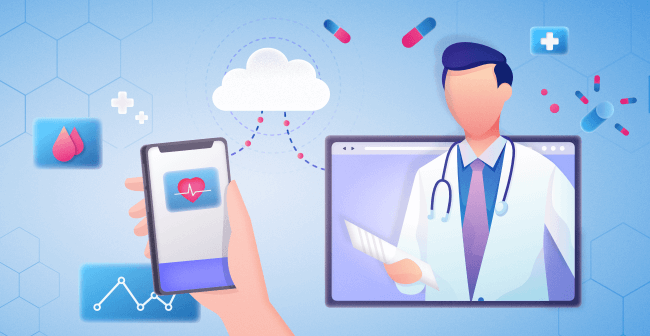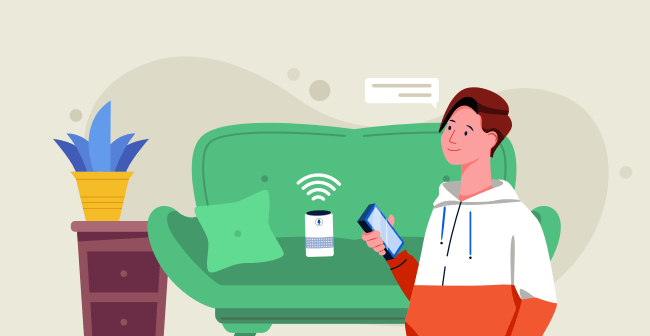The Centers for Disease Control (CDC) sees 1.7 million health-acquired infections in US hospitals alone. Not only does this increase during pandemics, but it also leads to shortages of health professionals and medical supplies when we need them the most.
IoT in the healthcare industry solves this problem in the easiest of manner, especially during pandemics like the coronavirus we are in right now -- where mobility is restricted, social distancing has to be maintained, and finding hospital beds is difficult.
At a Compound Annual Growth Rate (CAGR) of 21% during the forecast period, the global IoT in the healthcare market is projected to grow from USD 72.5 billion in 2020 to USD 188.2 billion by 2025.
This shows how promising technologies like IoT and AI help the healthcare industry, especially during global medical emergencies, the kind we live in right now.
Table of Contents
1. Role of IoT in Healthcare During the Coronavirus Pandemic
Here are some examples of IoT in healthcare examples that showcase how imperative IoT devices are during times of a pandemic like the one we are in right now.
Tracking the Coronavirus Pandemic
MIT researchers have now found that asymptomatic people may differ from healthy individuals in the way that they cough. These differences are not decipherable to the human ear. But it turns out that they can be picked up by artificial intelligence.
The AI model detects asymptomatic COVID-19 infections through device-recorded coughs. A user could log in daily, cough into their phone, and instantly get information on whether they might be infected and, therefore, should confirm with a formal test.
Connected Thermometers
Another IoT in healthcare example is connected thermometers. At hospitals, IoT thermometers measure the body temperature and notify the differences in real time. With the help of an IoT Access Controller for continuous monitoring, these devices receive and transmit patient data from the sensors to medical personnel in real time.
This gathered data from more than a million connected thermometers help generate maps indicating those US counties seeing an increase in high fevers. In India, a team of product experts engineered a contactless fever detection system that uses AI-based thermal imaging to remotely read any individual's skin temperature passing through the camera range.
Smart Wearables
The future of IoT in healthcare will see a lot of unconventional smart devices. In China, IoT devices like bracelets and rings are in sync with AI platforms that provide constant monitoring of vitals like body temperature, heart rate, and blood oxygen level. The IIT-Istituto Italiano di Tecnologia researchers have designed suits with thermal sensors to observe human body parameters and automatically alert users when their body temperature goes beyond 37.5 degrees.
2. Benefits of IoT in the Healthcare Industry
Here are the benefits of IoT in the healthcare industry. These are the points that show why the future of IoT in healthcare is bright.
Real-Time Monitoring and Tracking
Smart medical IoT devices connected to patients’ smartphones collect and transfer vital data like heart rates, blood pressure, oxygen, blood sugar levels, weight, and ECGs.
This health data collected from IoT devices is stored in the cloud and is easily accessible by an authorized person, like a physician, insurance company, hospital staff, or any other healthcare practitioner, in real-time, regardless of where the patient is.
The Center of Connected Health Policy conducted a study indicating a 50% reduction in the 30-day readmission rate because of remote patient monitoring of heart failure patients.
In the future, considering the necessity of monitoring patients remotely, IoT devices will be capable of recording more complex variables for doctors to keep track of.
Quick and Precise Treatment
IoT devices make it possible to process patient data at record speed (to be precise, a minute) that would typically require doctors to spend hours on it.
In addition, the Internet of Things, combined with Artificial Intelligence and Machine Learning, can also help find possible treatments and cures.
For instance, AI startup, BenevolentAI, based out of London, explores the cure for COVID-19 by scanning the existing available drugs.
Healthcare professionals can remotely find out whether the patient has taken drugs using medical apps for doctors. If not, the therapist can call and remind a patient about that or even further. It is possible to automate the entire process.
Digital Assistance
IoT in the healthcare industry is the need of the hour and will also flourish in the future because it offers digital assistance in 3 ways.
1. Remote Monitoring
One important IoT in healthcare applications is Remote Monitoring. IoT helps monitor patients remotely, as mentioned in point 1. Livongo Health, a range of remote IoT monitoring devices for "chronic diseases," has expanded its quarterly guidance in April 2020.
2. Telehealth Consultations
The only possible way to consult doctors during lockdowns is via video conferencing. People are also finding it to be more convenient. Therefore this trend might rise in the future.
3. Digital Diagnostics
Many digital diagnostics solutions are still in the development stage. Yet some are published for public use. This IoT in healthcare applications is going to see a massive surge, considering how convenient it is. Digital thermometer manufacturer Kinsa experienced a massive rise in usage as the pandemic swept through the US. Kinsa helped track the illness even before COVID-19 sick patients went to the hospital.
3. Challenges of IoT in the Healthcare Industry
The challenges of IoT in the healthcare industry are:
Data Safety of Personal Health Information
Patients' data safety is one of the most essential elements to take care of while using IoT in the healthcare industry. And failure to do so is one of the most significant threats to data security and privacy that IoT devices pose.
This is because many IoT devices lack standard data safety protocols. There is also significant ambiguity regarding data ownership.
These factors allow cybercriminals to hack into IoT devices and compromise patients' Personal Health Information (PHI).
Data Overload & Accuracy
Data aggregation and data processing are difficult due to the different communication protocols & standards it uses.
IoT devices record a massive volume of data. The massive data collected needs processing to deliver important insights.
Since more devices are connected, which record more and more data, the sheer volume of the data is so tremendous that deriving insights from it is becoming more difficult, resulting in poor decision-making.
Affordability
IoT devices are not made for the common public yet, since they are not very pocket-friendly.
The rise in healthcare costs has got everyone worried in developed countries.
This has created a culture of "medical tourism" where patients of developed countries who suffer from critical health conditions travel to developing countries to get their medical procedures done. Here they get the facilities at ten times a lesser price than what they would get back home.
4. Role of IoT For Different Healthcare Players
Here is how the application of IoT in the healthcare industry is beneficial for people across the healthcare industry.
IoT for Patients
IoT Devices help doctors and patients remotely stay in touch around the clock in the form of wearables like fitness bands, oximeters, and other wireless devices like heart rate, sugar, and blood pressure monitoring bands. This helps doctors to give patients access to personalized attention. These IoT devices remind a patient about the calorie consumed, exercise checks, daily appointments, blood pressure variations, heart rate, oxygen levels, and much more.
IoT for Physicians
By using wearables and other home monitoring IoT devices, physicians and other medical personnel can effectively and proactively track patients' health, regardless of their location.
They can also remotely check whether the patient had their medicines on time, monitor their vitals, and know when they need immediate medical attention. Additionally, data from these medical IoT devices help physicians identify the potential treatment process for patients to reach the needed outcomes.
IoT for Hospitals
Since IoT devices are tagged with sensors, they can be used to track the real-time location of medical equipment in the facility/facilities like oxygen pumps, wheelchairs, defibrillators, nebulizers, and other monitoring equipment. The location of all medical staff sprawled across locations can also be tracked.
IoT devices also help in pharmacy inventory control and environmental monitoring, for instance, checking refrigerator temperature and humidity and temperature control.
IoT for Health Insurance Companies
Insurance companies can use health monitoring devices to capture data for their underwriting and claims operations. This captured data will help in fraud detection. IoT devices help make insurance procedures like underwriting, pricing, claims to handle, and risk assessment processes transparency between insurers and customers more transparent.
Insurers can give customers incentives to actively share their personal health information gathered by connected IoT devices. Mediclaim companies have a reward system through a mobile app to keep track of customers' footsteps, calorie count, adherence to treatment plans, and precautionary health measures, helping patrons stay healthy and not fall seriously sick often.
Conclusion
IoT in healthcare was always a much-needed revolution needed to make the medical facilities better for everyone involved, from patients to doctors and even the medical insurance staff. This coronavirus pandemic has only made the healthcare industry realize how necessary IoT is in healthcare. With this pandemic forcing humans to interact less and rely more on digital technology, even healthcare has only proved how promising the future of IoT in healthcare is post-2020.















Leave a Reply